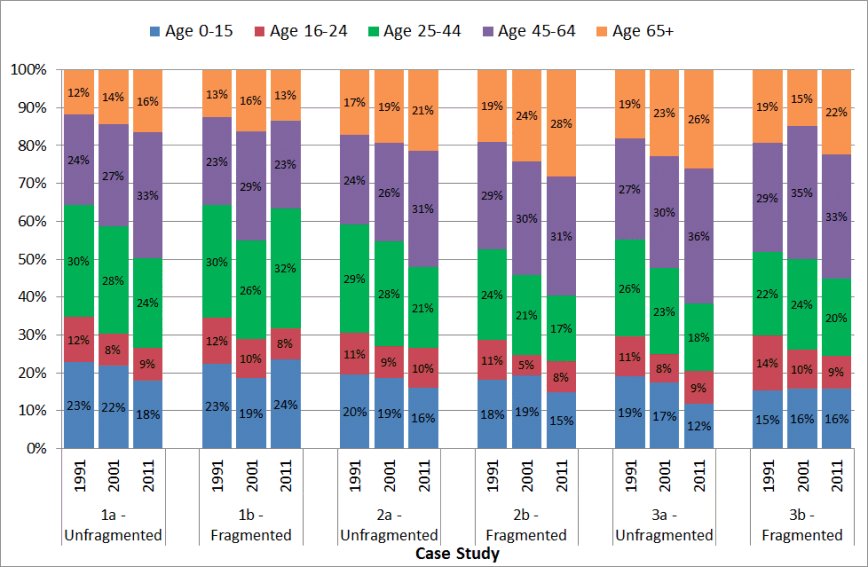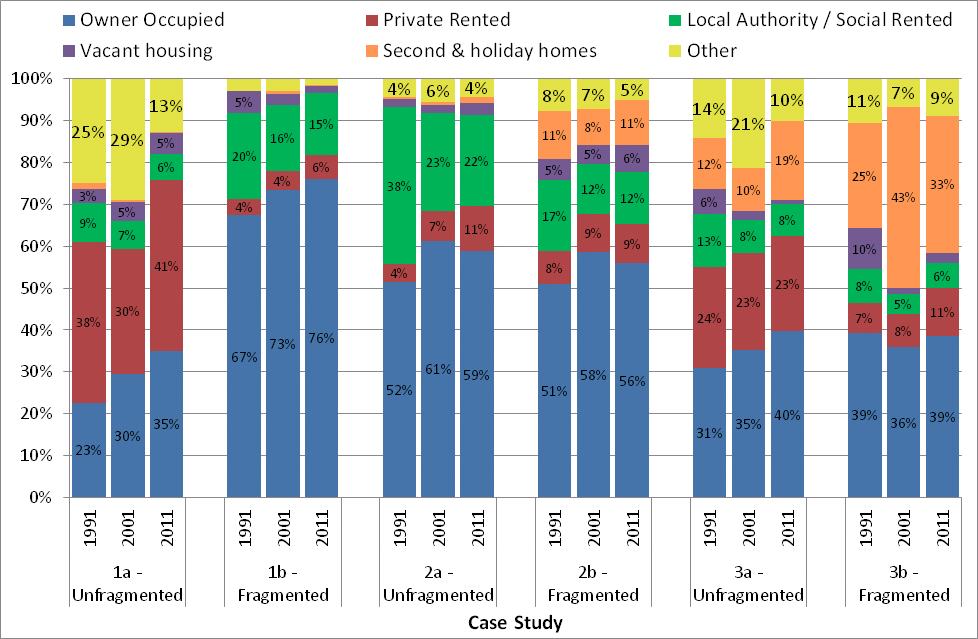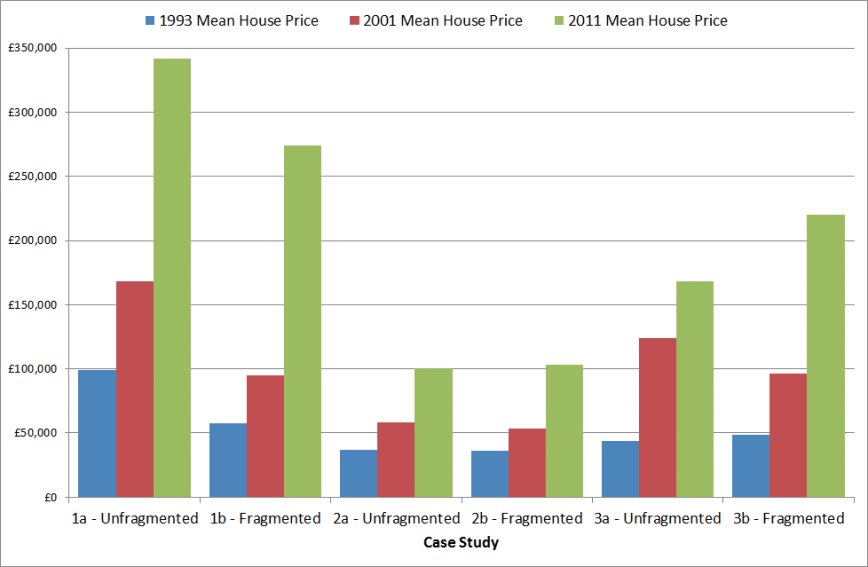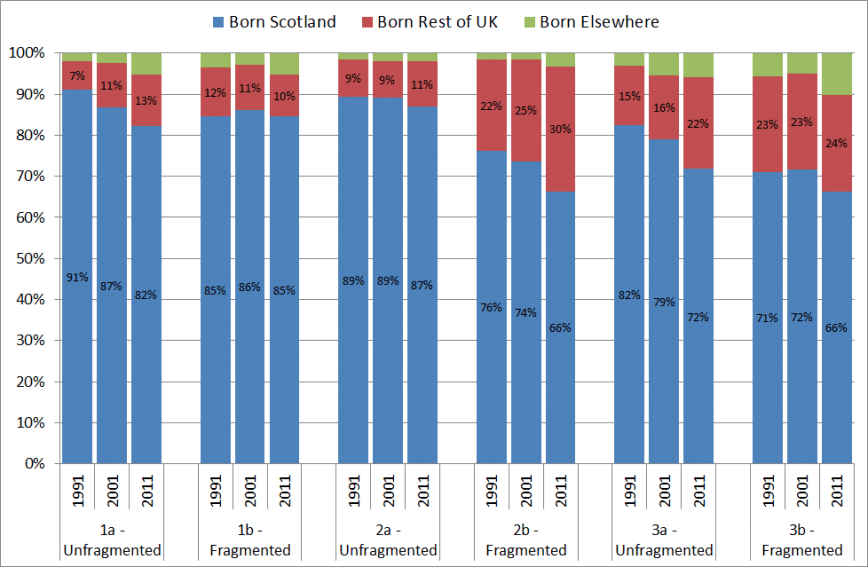Impact of diversity of ownership scale on social, economic and environmental outcomes
Report on the impact of diversity of ownership on the socioeconomic outcomes for rural areas.
People
In all case studies, population change was seen as a key driver of change. Focus group participants did not intimate that they believed land ownership factors were a significant contributory factor in driving demographic change, rather suggesting that changes occurred naturally as a result of wider economic and societal changes (mechanisation, urbanisation, counter-urbanisation, commuting, etc.). Similar demographic changes to those observed in wider rural Scotland (Thomson: 2010, 2012) were reported by participants, particularly the issue of an aging population: although it was not always seen negatively, with examples given (1a) of increased local volunteering from a highly skilled group (similar to findings reported by Woolvin and Skerratt, 2012). All case studies suffer from out-migration of young adults as they seek education and employment opportunities (as reported for wider rural Scotland by Atterton and Brodie, 2014). However, it was noted that businesses now struggle to recruit young workers in most of the case studies, instead being reliant on transient / migrant labour.
Population census data suggests [39] that the fragmented case studies were each more likely to have experienced population growth between 1991 and 2011 than their unfragmented counterparts. Over this period, the population of case study 1a declined by about 18%, whilst in 2a it was static, and in 3a there was modest (4%) growth compared to the more fragmented case studies where there was a 63% population increase in 1b, a 14% increase in 2b and a 13% increase in 3b. The working age population (16-74 years) changed by a similar proportion to the total population in each case study. [40]
However, these changes fall within the range of diverse patterns of demographic change that rural communities across Scotland have experienced (Thomson and Carson, 2014). Furthermore the influence of land ownership on population growth is unlikely to be simple or direct. For example, population growth reflects both employment and housing opportunities. The latter may be affected by the willingness of landowners to release land for new housing, but also by existing residents' and planning authorities' willingness to accept housing (re-developments) or indeed to agree on how the existing housing stock should be allocated. Equally, the preferences of potential residents with respect to different types and quality of housing affects demand in any particular location. Given general declines in land-based employment, job creation to retain and/or attract residents is more likely to be driven by business (or public-sector) developments not reliant on land per se, and/or by developments in (and good transport connections to) nearby urban areas. Hence, again, more detailed information on places of work and occupation of residents would be required.
Figure 15 Population structure, 1991 to 2011

Figure 15 highlights ageing populations in all case studies with the exception of 1b (which has been influenced by commuters and growth of the main village). Over the period 1991 to 2011, only 1b and 3b (both fragmented) maintained the proportion of school children. All areas had an increase in the over 65 year old grouping, and, with the exception of 1b, had a rise in the proportion of 45-64 year olds. Again, with the exception of 1b, the proportion of 25-44 year olds fell in all case studies (by 8% in 2a and 3a), meaning that there are fewer younger workers available in each area. In the more remote case studies (2 and 3), the focus group commented that there have been fewer young workers available over the last 40 years, and that there is now an expectation that 16-24 year olds leave the area to attend further / higher education or to seek employment opportunities. These demographic patterns are largely representative of the general population structure of accessible rural areas (case study pair 1) and more remote locations (case study pairs 2 and 3) as well as regional demographic patterns (Thomson 2010, 2012; Thomson and Carson, 2014).
Society
Good-quality, affordable homes
It was considered by the focus groups that the quality of housing standards in all case studies has improved dramatically over the study period, particularly in the last 40 to 50 years. The introduction of electricity, phones, insulation, central heating, modern appliances, etc. in most households, coupled with the a reduction in over-crowding of housing were reported as having helped in significantly improving the quality of life of householders, although it was acknowledged by respondents that the pace of improvement has often been at the behest of the landlord, whether private or public.
The focus groups each revealed how there was some housing investment by local authorities in the 1930s to 1960s. This was followed by the introduction of the Right to Buy initiative in the 1980s, that led to increased private housing ownership and reduced social housing stock.
Figure 16 Tenure of housing stock 1991-2011

Using population census data, Figure 16 shows how the housing stock in case studies was occupied between 1991 and 2011. With the exception of 2a, which is influenced by urban housing stock (hence higher reliance on social housing), both the other unfragmented case studies had much higher reliance on private rented accommodation (41% in 1a and 23% in 3a during 2011). There is a tendency towards greater second-home ownership in the more remote case studies (11% in 2b, 19% in 3a and 33% in 3b during 2011). It should be noted that the population census variables are not consistent for the "other" category with, for example "rented with job" accounting for 25% of housing stock in 1a in 1991 and "living rent free" accounting for 14% of housing stock in 1a 2011.
Feedback from the focus groups suggested that where there had been a reduction in estate / farm workers, the vacated housing was generally utilised for private rental (1a, 3a) or for holiday lets / second homes (2b, 3a, 3b) although here was still some tied housing provision for retired estate workers (1a). Old redundant farm and estate buildings have often been converted into housing (1a, 2a, 2b, 3a, 3b).
Lack of affordable housing (to buy or rent) is one of the factors that focus group participants in all case studies said led to out-migration of younger families. There was difficulty in finding affordable housing for locals in a number of case studies (for example, only 6 out of 70 houses built in a village in 1a were affordable, whilst in 3b an estimated 7 out of 400 homes in the main village are affordable), principally due to demand pressures from commuters (1a, 1b) and second-home owners (3a, 3b, 2b). Furthermore, it was suggested that, even where affordable housing existed, some was inappropriately located as there were no local employment opportunities available for the potential new residents. It is interesting to note that in 3b one smaller village has retained its 'affordable' status due to plots of land not being sold off by the landowner to second-home owners/developers, which has led to this village having more permanent residents and younger families than elsewhere in the parish, and being described as having " not changed at all".
In 1b where there was rapid housing development, the focus groups reported how housing developers made option agreements with the farmers who owned land around the village. The growth of housing within the parish was attributed to: (i) landowners' willingness to sell; (ii) Local Plan decisions; and (iii) demand due to rising population. The route of the road development was important in determining where the housing development took place, and was not driven by landowners.
Figure 17 Average house price 1993-2011 [41]

Figure 17 shows how rapid house price inflation affected both case study areas 1 and 3. Case study 1a saw a 245% increase and 1b a 375% increase between 1993 and 2011, with 3a having 280% growth and 3b 350% growth over the period. In case study pair 2, both areas experienced more modest (170-180%) growth in house prices. Focus group participants commented that in 1a and 1b competition from commuters has led to this rapid growth in house price (despite developments increasing supply), whilst in 3a and 3b it was considered that this inflation was driven by demand for second homes in a picturesque area. Similar patterns have been reported for other accessible and more remote locations across Scotland (Thomson, 2012).
Table 8 shows the difference in housing type between case studies. Case study 2a (unfragmented) had the highest proportion (75%) of lower value housing (Council Tax bands A to C) in 2011; this is influenced by some urban housing being part of the study area. 2b had slightly lower proportions of bands A to C housing, with a third of the housing stock classed as bands D and E. Both areas in case study pair 1 had only 20% lower value housing in 2011, with both dominated (80%) by housing in bands D-H, and focus group participants stressed that this was due to the large number of new-build homes targeted at high-income earners. Both areas in case study pair 3 were broadly similar, with more than half their housing stock in bands D to H. Housing stock turnover [42] figures show no discernible pattern, although 1b and 3b (both fragmented) had greater turnover in 2011 than the other areas (influenced by housing developments and village growth in 1b, and by second homes in 3b).
Table 8 Council tax band of dwellings, 2011 and housing stock turnover, 2001 and 2011
| |
% of Dwellings in Council Tax Band | Housing stock turnover | ||||
|---|---|---|---|---|---|---|
| Case Study | A | B & C | D & E | F & H | 2001 | 2011 |
| 1a - Unfragmented | 3% | 17% | 32% | 48% | 3.7% | 2.0% |
| 1b - Fragmented | 4% | 16% | 37% | 43% | 3.8% | 4.2% |
| 2a - Unfragmented | 15% | 60% | 21% | 4% | 3.2% | 1.5% |
| 2b - Fragmented | 18% | 42% | 33% | 7% | 4.1% | 1.3% |
| 3a - Unfragmented | 6% | 41% | 33% | 20% | 4.8% | 1.9% |
| 3b - Fragmented | 10% | 31% | 34% | 26% | 4.3% | 4.4% |
Migration
Using place of birth as a proxy for migration, population census data reveals broadly similar proportions of people in each category (see Figure 18), with around 80% to 85% born in Scotland. Case study 2a has the highest level of population born in Scotland, and for the more remote case studies there are higher proportions of people born in the rest of the UK or abroad
Figure 18 Residents' place of birth, 1991 to 2011

All case study focus groups reported both in- and out-migration as important drivers of change in their communities. Population increase at the time of the Second World War, as military bases were established, had a significant impact on the local population in 2a, with some people remaining in the area after the bases were mothballed. More generally, out-migration caused by a significant reduction in land-based employment was universally described as having negative consequences for communities, although the drivers were not related to land ownership, rather to mechanisation of farming and forestry.
In-migration, since the 1970s, whilst welcomed for the survival of villages, was often framed negatively due to perceptions that in-migration could lead to reduced social cohesion and community engagement. Differing forms of migration were, however, reported in each case study: regional growth attracting high income migrants (1a, 1b), growth of tourism attracting low paid, seasonal workers (3a, 3b), migration from other parts of UK and abroad (2a, 2b) with a more transient population (2a). These reported perceptions may, however, over-represent older participants' views and reflect the underlying negative feelings towards incomers common in the 1970s and 1980s (Burnett, 1998) and/or the lack of acknowledgement of the impact of wider societal change, including the changed circumstances and dynamics of family life (e.g. Hickman et al., 2009)."
Community Activities and Spaces
Schools: Issues relating to schools were raised in all case study discussions, although with different outcomes in 1b where there was rapid population growth. In 1b, the population influx since the 1970s put pressure on the local primary school, with issues of over-crowding (which reappeared during the phase of housing development over the last decade). A new school was completed in the 2000s that was apparently 'full on day one' with a second new primary school currently under construction. In case study 1a, the focus group explained that the landowner had fought against the amalgamation of the primary schools in the two main villages as he felt it would change the character of the villages and affect the type of in-migrants to the area. The school rolls in 1a have now expanded and the schools appear to be more sustainable. In contrast to this, other case studies have seen closure of most primary schools in smaller villages (e.g. three out of four closed in 2b), with subsequent consequence in that the area has become less attractive for young families, which means recruitment of appropriate staff has been more difficult.
Transport: All case study focus groups (with the exception of 1b) discussed a reduction in public transport (bus service decline and railway station closures) as having negative impacts on their communities (particularly for young and elderly people) [43] , whilst acknowledging that the rise in car ownership has led to improvements in the quality of life for individuals able to travel greater distances for work, shopping, leisure activities, etc. However, there was generally an underlying tone that the car, and greater mobility of residents, was a key contributory factor in the demise of local shops, services and in community cohesion. Increased volumes of road traffic were considered negatively from a social and environmental perspective (particularly where local roads were used as 'rat-run' shortcuts - 1a, 1b or increased volume of heavy goods vehicles - 2a), although welcomed from a business perspective with regard to tourism (2b, 3a, 3b) and freight (2a).
Services and facilities: A concern in some case studies was the reduction in availability of local health care provision, through loss of local doctors and nurses (1a, 1b, 2a) due to centralisation of services and improved population mobility. This was reported to have had negative impacts on the sense of community in the area, as well as losing lynchpins of the community - well known, highly educated and trusted professionals. It was felt by participants that this has led to older people moving away from the area as their health starts to decline, in order to seek closer health care. These concerns follow Hall and Skerratt (2010), who highlighted that attracting health care professionals to some more remote locations is problematic and that accessibility to doctors and pharmacies is already difficult for some elderly residents, particularly when they do not have access to private transport. These and other issues concerning healthcare provision in rural areas were acknowledged by the Scottish Government through the publication of Delivering for Remote and Rural Healthcare (2007) [44] - a vision of how to deliver a sustainable health care service across rural Scotland. It should be noted that there was no connection made, by focus group participants, between the loss of these services and landownership factors.
In some case studies (1a, 1b), the village halls are largely owned and maintained by the local authority but the closure of village halls in many villages across 3a was considered a major barrier to locals socialising and gathering, as there is often now a lack of community spaces. Whilst not reported as directly linked to land ownership, the demise of local shops, banks and tradesmen were reported as a negative trend in all case studies, although it was acknowledged that increased mobility, shorter drive times, changed shopping patterns, internet shopping, etc. have had positive impacts on local residents' quality of life. Yet despite these positive societal developments remote rural households can still face 10-40% higher costs to reach minimum acceptable living standards (Hirsch et al., 2013) and high delivery costs for internet purchases and high heating costs (Sutherland, 2015).
There is considerable coverage of the issues in delivering acceptable broadband services to much of rural Scotland (Sutherland, 2015; Ashmore, et al., 2015), and whilst there was some complaints about poor connectivity speed from case study participants, many commented on how the internet and broadband had improved the quality of life of local residents and also led to business opportunities.
Community Cohesion: Whilst overall service and facility provision has decreased in most case studies (local shops, post offices, schools, church, village halls, etc.) the large influx of residents in case study pair 1 has meant that some shops (1a, 1b) and the local church (1a) have been maintained, providing services to the whole community. Focus group participants in most case studies emphasised that there were now fewer community social functions than in the past, driven by modern technology (television, internet, etc.) and improved mobility. There was also an underlying sentiment that in-migration has had a negative impact on community cohesion and identity, due in part to people now not knowing each other, but also to less engagement in community life from incomers (particularly when they were not working locally). This sentiment was characterised by the statement that " It's not as community-minded as it was, because we are getting people who just commute, and don't join in with the local activities." However, again, it should be acknowledged that the focus group sentiments may be influenced by the embedded negative attitudes of older, longer term, 'local' participants towards incomers, and that such attitudes may not be shared universally by all parts of a community (Burnett, 1998; Atterton, 2012; Bosworth and Atterton, 2012).
In 1b it appears that the main village has grown beyond a critical point, and that concerns surrounding residents integrating and community cohesion have lessened as there is greater acceptance that it has grown into a commuter town, although there remains a challenge in getting volunteer support for clubs, youth groups, etc. In 3b, where there has been a growth in second-home ownership, it was notable that in the focus group distinctions were made between 'long-term, permanent residents' and 'second home/holiday home owners', highlighting a real lack of integration between these two sub-communities (as characterised by Burnett, 1998), which had been more integrated in the past.
Community engagement and assets: The role of land management 'factors' was considered important when there is an absentee landowner, and it was felt by some participants that factors do not always attempt to get " a feel for the community"; this can lead to them being unwilling to engage in or lead on community initiatives.
In 2b the former estate owners had gifted to the community land which is used for parks, but also for the site of a Community Association enterprise that generates about £25,000 per annum for the community. In 3b, a community group has taken ownership of a hill farm and developed several affordable homes for rent through renovation of farm buildings (through the Rural Empty Properties Grant scheme) and a community/public hire facility has also been built, hosting musical events, etc. Additionally in 3b, the community benefits from income from a nearby wind energy development that allows investment in community projects and activities, and has " helped to keep local groups going". In 1b, it was discussed that despite the growing wealth of the community, as a result of industrial developments and in-migration of wealthy commuters, able to afford executive-style new housing, the village itself had not significantly benefited from perceived local wealth, other than through donations to fund-raising initiatives. Nonetheless, two local businesses were praised for being 'community-minded', through the donation of land for community activities.
These issues highlight that it is the benevolence and motivations of individuals with access to land and capital (whether large or small) that are important in delivering community benefits where there is a lack of provision. Where scale of ownership has been preserved, local estates remain a background feature for some residents, while being more relevant and important for others (e.g. tenant farm families).
Governance: In a number of the case studies the participants expressed different degrees of dissatisfaction and disappointment about the impacts that centralised local government has had (3a, 3b). Local Authorities were described as "remote and separate", and as "operating an urban-suburban model, which does not understand the needs of rural areas" (3b).
Community Outdoor Benefits
Local agricultural and horticultural shows, equestrian events and highland games were considered locally important events, that can bring the community together and which stimulate high levels of volunteering. Often the estates / farms host these events, providing community and visitor access to their land.
Most of the communities explained how residents use the privately owned land for recreational access whether fragmented or not, although there were some focus group complaints about barriers being erected on private estate roads. A wide range of recreation activities and events were mentioned across the case studies, including: bowling, golf, football, rugby; informal walking and cycling; boating; fishing; festivals; shows; highland games; informal camping; dog walking, etc. In 1b, there were concerns that a consequence of the rapid expansion of the town is that there is limited green space for recreation activities / space for children to play.
Contact
Email: Graeme Beale, socialresearch@gov.scot
There is a problem
Thanks for your feedback